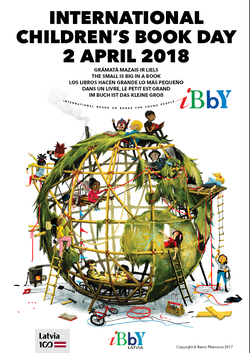2018 Latvia
The small is big in a book
People are inclined toward rhythm and regularity, just as magnetic energy organizes metal shavings in a physics experiment, just as a snowflake creates crystals out of water. In a fairy tale or poem, children enjoy repetition, refrains, and universal motifs because they can be recognized anew each time – they bring regularity to a text. The world gains a beautiful order. I still remember how as a child I struggled with myself over justice and symmetry, over equal rights for the left and the right: if I tapped a beat on the table, I counted how many times each finger got to play, so that the other ones wouldn’t be offended. I tended to applaud by patting my right hand with the left, but then I thought that it was unfair and learned to do it the other way – left on right. This instinctive aspiration for balance is funny, of course, but it shows the need to prevent the world from becoming lopsided. I had the feeling that I was the one who was responsible for the balance of it all.
Children's inclination toward poems and stories likewise stems from their need to bring regularity to the chaos of the world. From indeterminacy, everything tends toward order. Nursery rhymes, folk songs, games, fairy tales, poetry – all these rhythmically organized forms of existence help small people structure their presence in the greater chaos. They create an instinctual awareness that order is possible in the world and everyone has his or her unique place in it. Everything works toward this goal: the rhythmic organization of the text, the rows of letters and the design of the page, the impression of the book as a well-structured whole. The great is revealed in the small and we model this in children's books even if we are not thinking about God or fractals. A children's book is a miraculous force that promotes the small person's great desire and ability to be. It promotes his or her courage to live.
In a book, the small is always big, instantly, not just upon reaching adulthood. A book is a mystery in which something unsought can be found, or something beyond one’s reach. That which readers of a certain age cannot grasp with their minds remains in their awareness as an imprint and continues to act even if not thoroughly understood. A picture book can function as a treasure chest of wisdom and culture even for adults, just as children can read a book intended for adults and find their own story, a hint about their budding lives. Cultural context shapes people, laying down the bed for impressions that will arrive in the future, as well as for the trying experiences they will have to survive while keeping themselves whole.
A children's book signifies respect for the greatness of the small. It signifies a world that is created anew each time, a playful and beautiful seriousness, without which everything, including children's literature, is just empty busywork.
In short:
A book makes the small person intuit that order is possible in the world, and everyone has a unique place in it. Everything works toward this goal: the rhythmic organization of the text, the rows of letters, the design of the page, the impression of the book as a well-structured whole. The great is revealed in the small and we model it in children's books. A book is a mystery in which something unsought can be found, or something beyond one’s reach. A children's book signifies respect for the greatness of the small.
Written by Inese Zandere
Poster illustrated by Reinis Petersons


